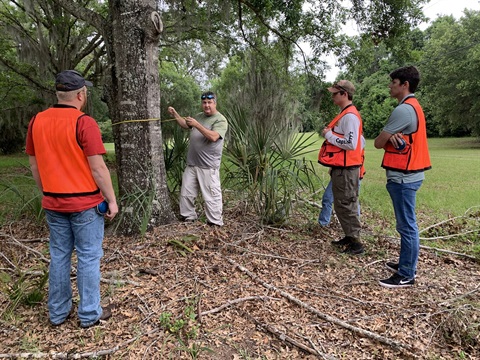University of Florida researchers begin Gainesville tree inventory
Published on June 05, 2024

Be on the lookout for University of Florida researchers donning orange vests as they measure trees throughout Gainesville, as part of a study funded by the City of Gainesville.
For the next two years, a team led by Associate Professor of Forest Systems Michael Andreu, Ph.D., and UF Environmental Horticulture Assistant Professor Ryan Klein, Ph.D., will take inventory of trees on municipal rights-of-way, as well as developed areas of city parks, and complete an ecological analysis of Gainesville’s public and private urban forest.
The study will evaluate various components and services of the city’s urban forest. The same study was completed by Andreu’s team in 2016. That year, trees saved Gainesville residents an estimated $7.7 million in energy costs associated with shading of residential buildings.
“We’re looking forward to the study results. How can you best manage Gainesville’s urban forest if you don’t know exactly what you’ve got?” said City Arborist David Conser. “We expect the information gathered will help us to continue to maintain, and even enhance, this incredible public asset for years to come.”
The city published an urban forest management plan in 2020 with support from the University of Florida Institute of Food and Agricultural Sciences (UF/IFAS) Extension team. The plan included metrics, derived from this research, that can be used to understand how the urban forest is changing and serving the goals set out by the city and its residents.
“The 2016 study established a baseline for what the forest looked like (species, size, how distributed across the city),” said Andreu. “With this second iteration, we will begin to see how it is changing over time,” he said.
The new study should be completed in late 2026. The information gained through the inventory of urban trees also will help the city estimate the total percentage of the tree canopy; assess the urban forest's overall health, diversity, and size distribution; estimate the economic benefits provided by the current canopy; compare the current and previously reported economic benefits; build public support for the city urban forestry programs; promote better tree care; and assist in determining locations for the Urban Forestry Division to plant new trees.